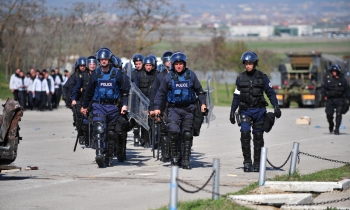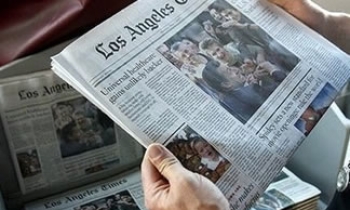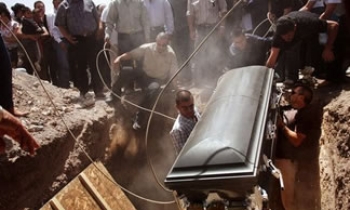(KRT) - The Sun Herald and its predecessor newspapers, The Daily Herald and the Sun, have a proud 121-year tradition of never having missed a publication day. That is pretty amazing when you consider that we do get the occasional hurricane in these parts.
Last Sunday afternoon, our staff hurried to put the finishing touches on our Monday edition so that everyone could speed to a place where they would feel safe to meet the fury of Katrina, rapidly bearing down on the Gulf Coast.
The last posting I read from Weather Underground blogger Steve Gregory almost screamed "DANGER" in red letters. It spoke of the then-Category 5 storm in almost reverential terms and predicted a 30-foot storm surge in the Bay of St. Louis, with giant waves crashing in atop the surge.
On one level that sounded unlikely, perhaps even impossible as the greatest previous storm-surge in U.S. history was the 22-foot surge that struck Pass Christian in 1969 when Camille battered the Mississippi Coast.
On the other hand Katrina was blowing 175 mph winds and growing to an enormous size, filling much of the Gulf - and dwarfing Camille in her scope.
We knew we were in a lot of trouble. A front-page editorial in last Monday paper said:
"Those who have chosen to remain are expected to experience one of the greatest furies that nature can unleash.
"The storm is almost certain to change the face of South Mississippi forever."
How prophetic. But never in our most-expanded vision of the impact of Katrina did our nightmare reach the apocalyptic proportion that became reality over the course of last Monday.
When Katrina finally moved on to hit vast portions of upstate Mississippi she left behind a devastated Coast. Her flooding and Cat 4 winds damaged or destroyed 75 percent of all structures in Harrison, Hancock and Jackson Counties.
Last Monday morning Mississippi Power Company provided electric power to 195,000 business and homes. By that evening, they now estimate, their customer base had shrunk to 172,000. Twenty-three thousand of the previous customer structures no longer existed!
The 30-foot surge predicted by Blogger Gregory had been virtually met, recorded by Florida International University scientists at 29 feet. The surge obliterated almost everything in its path, and what the surge did not destroy the savage wind attacked.
Our world had changed beyond comprehension.
A few Sun Herald staffers waited out the storm in the Sun Herald building on DeBuys Road in Gulfport, along with Marlene Kler, our Operations Director. They did well because the building proved storm-worthy. There were some leaks, but overall we were in good shape.
Other Sun Herald staff returned to the newspaper as soon as the storm passed. It was apparent to everyone that this was a disaster of unparalleled dimension.
Prior to Katrina's arrival we staged a group of editors and page designers in Columbus, Ga., at our sister paper, the Ledger-Inquirer. A quick response force of Knight Ridder reporters, photographers and editors was poised for action in Montgomery, Ala., and they came through the damaged coast in the darkness of Monday night.
When Bryan Monroe, a news executive from our corporate staff in San Jose led the intrepid group into the Sun Herald, elation filled the building. The Marines had landed!
We had reported and photographed the storm story through the last hours of daylight Monday and we hit it again hard Tuesday morning. We sent our stories and photographs to Columbus where the presentation team created eight solid pages that represented our first printed draft of the history of Katrina.
Biloxi Mayor A.J. Holloway provided us with a poignant story of the biggest day of his life, and the headline which summarized the awful day.
"Our Tsunami." Indeed it was that.
The Tuesday edition was printed in Columbus at about noon and trucked to the newspaper, from which about 20,000 copies were distributed to shelters and other places where people gathered.
We had kept the paper's century-plus commitment to South Mississippi readers alive - we delivered a Tuesday paper in spite of Katrina. And while it was a matter of the newspaper's pride, I think the community had a sense of involvement in the success of our venture.
On some level, I think, it was a symbol that we were not defeated by Katrina. She had hit us hard but we were back in the publishing business on the news cycle, albeit an afternoon edition rather than a morning paper.
But let's go back prior to Monday. Throughout the storm sunherald.com continued to put out news about the storm as we had CONTINUOUSLY for days about the brewing storm.
We have learned that the Sun Herald isn't just a newspaper, though it certainly is that. The Sun Herald is a news provider through many mediums, including our Web address sunherald.com (www.sunherald.com).
Beginning Saturday, August 27, we launched our "Eye on Katrina" blog. This is our third hurricane blog, following Ivan last year and Dennis earlier in the 2005 season.
Geoff Pender launched the Katrina blog and later handed off to the veteran "bloginator" Don Hammack whose dispatches continued through today.
The worldwide interest in Katrina has brought unbelievable traffic to the Sun Herald Web site. The site normally draws about 65,000 daily viewers this week's traffic has hovered near the 1.5 million mark each day.
Our friends at Knight Ridder Digital have been a tremendous help, posting slide-shows and both audio and video elements to the site.
The reporting and photographer teams are posting new information as soon as it is available and edited in the Sun Herald newsroom.
With about 50 reporters and photographers dedicated to reporting the story I believe we have produced the most complete reporting on Katrina's impact on South Mississippi of any newspaper, website or any other media for that matter.
Beginning with Wednesday's edition we have produced daily newspapers of 24 pages, nearly all of which is news content.
The reinforcements from sister Knight Ridder newspapers has continued to flow in so that we can keep up with this giant story on the pace we are keeping which is blistering.
We have gradually raised our daily press run to 42,500, which is today's number. We have continued production in Columbus but believe by Monday night, for Tuesday's paper, we may be running on our own presses.
Distribution continues through a combination of some carriers and other circulation department workers, and reporters who fill their cars and truck when they head out to the field to distribute them wherever they see people.
The demand is incredible and the response is among the most gratifying experiences some of our news team has ever encountered. Because of the demand we have tried to ration the papers so that two or more readers can share.
We are hearing reports that in the neighborhoods a system is evolving where a single paper is shared at the owner's home or passed along from one house to the next.
As awful as this storm is and despite the difficulty of gathering the story amidst so much suffering and heat and the smell of death all around, there is a profound feeling of importance to the job we are doing.
Many, perhaps even most, journalists chose the profession because of their belief that they could do good - and provide a public service for the communities they serve.
In these days those dreams have been realized by many who are toiling out of the newsroom of this little newspaper. The stories of courage, and destruction, of life and death, have taken them to the pinnacle of their careers.
There will be much more to tell in the weeks and months ahead. We will probe how this could have happened, even asking the tough question - should it have happened?
And we will tell of the rebuilding of the Coast, and of the spirit of the people who will do that. It is a story of the life and terrible times of this storm and its aftermath. One which we are humbled and privileged to tell.
Stan Tiner is the executive editor of the Sun Herald in Biloxi, Miss. Contact him at tiner@sunherald.com.









